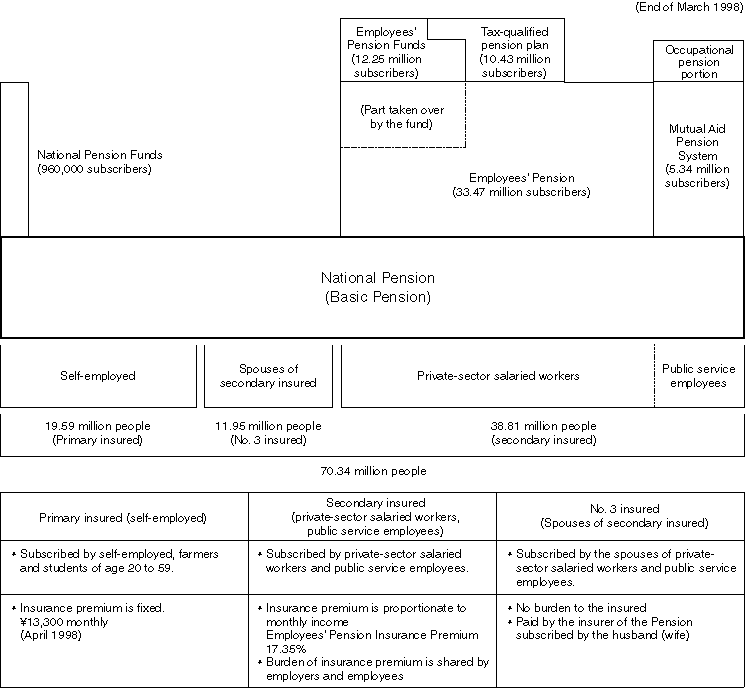
1. Improving the Public Pension System
1-1. The Role of the Public Pension System with Increasing Importance
Before the public pension system was established, people had to rely on the personal support of their children, personal savings, or income from their own work to maintain their living in their old age.
However, with the changes in the structures of industries and employment, it has become difficult for the elderly to rely on private support. Besides, there are some other reasons for it, namely, drastic population decrease in the primary industry, drop of the ratio of elderly people living with their children as a result of the increase of nuclear families, and concentration of younger generations in metropolitan areas. In addition, there have been some changes in the expectations and the ratio of the people with no intention for depending on their children is greatly increasing. Further, the increase of the average life expectancy has extended the life after retirement, and that has caused difficulty in relying on private care and savings. Thinking of personal savings, it is very difficult to estimate one's own life expectancy in one's young age and to start saving enough money for the life after retirement. While saving money for retirement life, unexpected level of inflation might occur, and in such a case the savings may not be enough to support the life in old age.
For these reasons, it is not easy to simply depend on private care and personal savings in the life after retirement, and the public pension system, which has been developed to facilitate social support to the life in old age, is becoming increasingly important.
1-2. Characteristics of the Public Pension System in Japan
The public pension system in Japan has the following characteristics: a universal pension system to benefit all citizens; a combination of a basic pension and supplements; the benefit provided for life time by maintaining the actual value through the mechanism such as indexation system; and maintaining long-term stable benefit and burden through the review of the system by conducting actuarial revaluation in at least every 5 years using the financing method of the stepwise raising premium method.
(1) The universal pension system
Before and shortly after the World War II, the public pension system in Japan was available only to employees in accordance with the Employees' Pension Insurance Law (Established as the Workers' Pension Insurance Law in 1942 and revised to the Employees' Pension Insurance Law in 1944). Later in 1959 the National Pension Law was established for the business owners and the unemployed in response to the acceleration of nuclear families, concentration of population in metropolitan areas, and envision of the aging society in the future. In April 1961, the pension system was commenced with the contributions stipulated in this law, and all citizens became eligible for the public pension system as it is a universal pension system.
(2) A system combining a basic pension and supplement
After the commencement of a universal pension system, the public pension system in Japan further developed with the advancement of individual systems such as the Employees' Pension, Mutual Aid Pension and National Pension. However, in order to resolve gaps and duplication of benefits and burden, and to prepare for the problems that threat the financial stability due to the changes in industry structure, a basic pension common to all citizens was established in 1985, and the Employees' Pension Insurance and Mutual Aid Pension were restructured so that they could be added to the basic pension as the second tier of remuneration-based pension.
Currently, all citizens subscribe the National Pension (the Basic Pension), and employees also subscribe the second tier portion of the Employees' Pension or Mutual Aid Pension. In addition, the National Pension Fund is provided as supplement for the self-employed, and the Employees' Pension Fund (EPF) is provided as supplement to the Employees' Pension. The basic pension secures the basic portion of the retired living, and the remuneration-based portion of the Employees' Pension and Mutual Aid Pension secures income for the situation where the person becomes incapable of earning income.
At the end of March 1998, the total insured population was 70.34 million, and among those the primary insured such as self-employed was 19.59 million, secondary insured such as private-sector salaried workers(Employees' Pension) and public service employees (Mutual Aid Pension) was 38.81 million, and No. 3 insured people who are the spouse of secondary insured were 11.95 million (Figure 3-2-1).
Figure 3-2-1. Structure of the Pension System

(3) Maintaining the actual value of the benefit and providing life-long benefit
Benefits of public pensions have been improved in response to social and economic changes. Particularly since 1965 the benefits were improved as the Employees' Pension realized \10,000 pension benefit and \20,000 pension benefit, and the National Pension realized \10,000 pension benefit for married couple and \20,000 pension benefit for a couple. In 1973 the Employees' Pension implemented \50,000 pension benefit, and the National Pension realized \50,000 pension benefit for a couple, and the price indexation was introduced to revise the pension benefit in accordance with the price increase. Thus the pension system has the mechanism to maintain the actual value of the benefit. Because of the price indexation, the public pension system was able to respond to the extreme price increase after the first oil crisis (Table 3-2-2) (Figure 3-2-3).
Monthly payment of the Old-Age Basic Pension in fiscal 1999 was \67,000 for the full benefit, and the revised standard payment of the Old-Age Employees' Pension (for a household with a full-time housewife and a husband) in 1994 was \231,000 monthly at the maturity of the system (value in FY1994, including the Old-Age Basic Pension). Using the price indexation, the actual value of the pension benefit will be maintained for life time, regardless of the length of life span.
Table 3-2-2. History of the Development of the Public Pension System
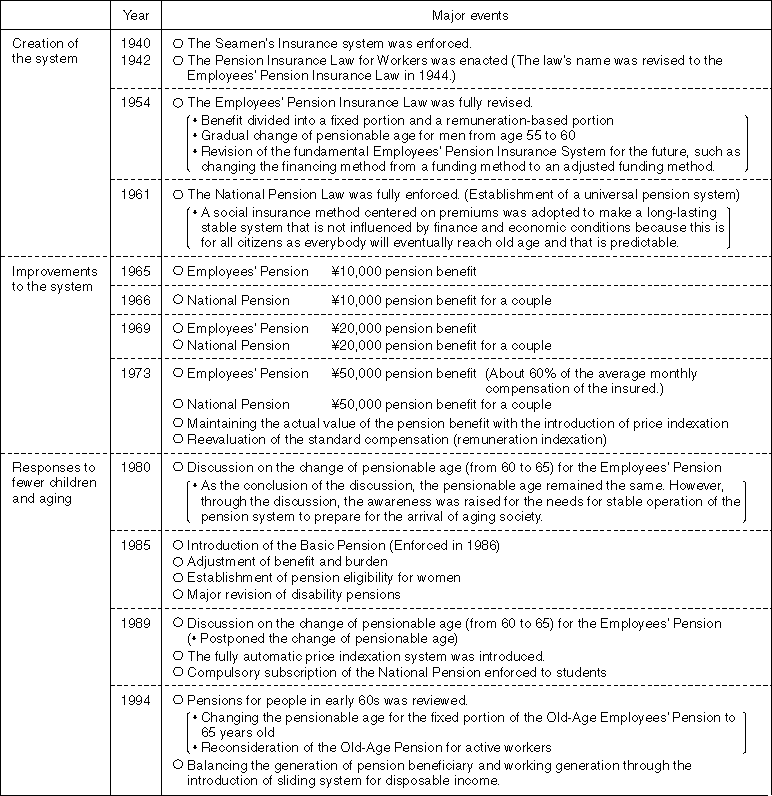
(4) The stepwise raising premium method and actuarial revaluation
When the Employees' Pension was first introduced, the level premium method was adopted for the financing method as it was a funding method to maintain the balance of revenue and expenditure with a fixed premium rate for the future. However, in 1948 a lower premium rate than the level premium rate was tentatively set with the consideration of the devaluation of reserve fund and payment capability during the drastic inflation after the war. In 1954 the system went through a fundamental revision, and a lower premium than the level premium rate was set in order to avoid a rapid increase of premium payment. Then in 1973, when the price indexation was introduced, a financing method called a stepwise raising premium method to set a temporal premium rate based on the future projection was adopted with the assumption of the stepwise increase of premium rate in the future at the actuarial revaluation.
Currently, the stepwise raising premium method is employed for the financing method of the Employees'Pension and the National Pension systems. It is based on the concept of "intergenerational support" that leaves bearing required funds to provide improved benefits in response to the upgraded standard of living and the increase of commodity price, to the future generations. Basically, the system contains the aspect of pay-as-you-go method (Note). At the same time, it also has the aspect of funding method to suppress the burden of premium on the working generation in the future by keeping a certain amount of reserve fund that yields operational revenue (Note).
Figure 3-2-3. Standards of Benefits and Premiums for the Employees' Pension and National Pension
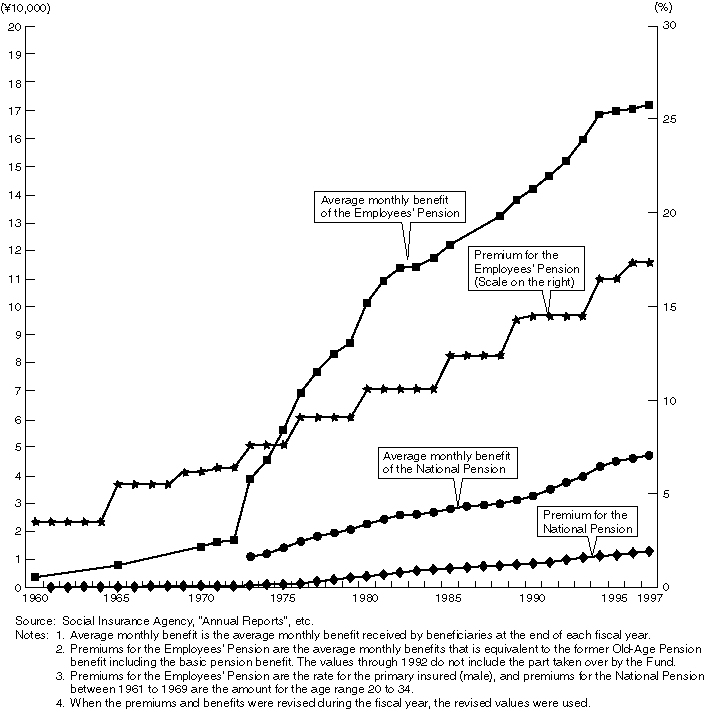
In case of the public pension system, the balance between benefit and burden is maintained for a long-term through the revision of the system by conducting the actuarial revaluation at least every five years to respond to the social and economic changes including the changes in population structure, employment structure, wages, commodity price, interest rates, etc. Through the implementation of such operation, the public pension system responds to the increase of commodity price and the average life expectation. It has become the essential financial security for the life after retirement.
(Note)
"Pay-as-you-go method" refers to a financing method to collect the required funds for the year's pension benefit from the insured of that year. On the other hand, "Funding method" is a financing method to accumulate premiums in advance for the payment of pension benefit in the future.
1-3. The Results of the Public Pension System
(1) One in every 5 people in Japan is a beneficiary of public pensions
Insured of public pensions can receive the benefits of the Old-Age Pension, disability pensions, or survivors' pension when they reach the old age or become disabled or survivor. At the end of March 1998, the total beneficiaries of public pensions were 37.20 million, and among them 23.46 million were the beneficiaries of the Old-Age pensions (excluding the equivalent of the new Old-Age basic pension), 7.62 million were the beneficiaries of the Old-Age pension (equivalent of the portion for the new Old-Age basic pension), 1.81 million were the beneficiaries of disability benefit, and 4.31 million were the beneficiaries of survivors' pension (Table 3-2-4).
While some people receive two or more pension benefits such as a basic pension and the Employees' Pension, the actual beneficiaries of the public pensions based on the Basic Pension Number without duplication are 26.27 million (at the end of March 1998) including the beneficiaries of the Old-Age Welfare Pension, and approximately one in every 5 people is eligible for some types of pensions.
(2) Public pensions to support the life of the elderly and working generation
(Beneficiaries of the Old-Age Pension benefit and the value of the benefit)
Beneficiaries of the Old-Age Pension benefit (excluding the equivalent of the new Old-Age basic pension) for each system are 13.54 million for the National Pension, 7.82 million for the Employees' Pension, and 2.10 million for the Mutual Aid Pension. The average monthly benefit is \47,000 for the National Pension, \172,000 for the Employees' Pension, and \223,000 for the Mutual Aid Pension (end of March 1998). According to "the Report on the Basic Statistical Survey of Wage Structure" by the Ministry of Labor, the average starting salary in 1997 was approximately \194,000 monthly for male college graduates and about \156,000 for high school graduates.
Table 3-2-4. Beneficiaries of Public Pensions and Average Monthly Benefits of the Old-Age Pension
(End of March 1998)
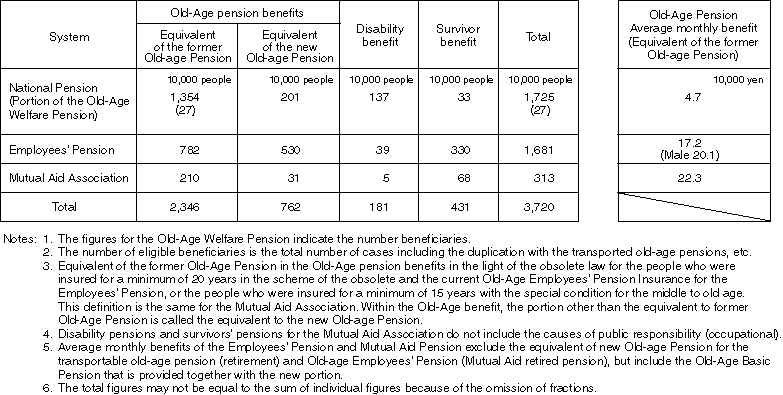
(Expectation for public pensions)
People have high expectations for public pensions as a source of income in their old age. According to the "Public Poll Concerning Images of Elderly Life" (September 1993) by the Prime Minister's Office, many people consider that financial security for their retirement life is the second major concern in their advanced age, following the health and long-term care of themselves and their spouse. According to "1994 Survey on the National Living Preferences" by the Economic Planning Agency, 76.2% of people expect public pensions to be the primary source of income in their advanced age, which is much greater than the expectation for other sources of income such as wages from their work 24.7%, personal pension 24.1%, and savings 18.4%.Furthermore, "The Public Opinion Poll on the Public Pension System" (March 1998) by the Prime Minister's Office indicates that more than 70% of people consider public pensions essential to their retired life, including 21.8% of "almost completely relying on public pensions" and 51.0% of "Primarily relying on public pensions with self-supporting efforts with personal pensions and savings" as the positioning of public pensions in the life plan of advanced age. This ratio is higher than that of the survey in August 1993.
(The share of public pensions in the income of elderly-only households)
The establishment of the public pension system drastically changed the financial situation of retired life. In 1957, before the enactment of the National Pension Law, about 80% of people over 70s were depending on their families to maintain their living. However, according to the "Comprehensive Survey of the Living Conditions of People on Health and Welfare" by the Ministry of Health and Welfare, the ratio of public pensions and public servants' pensions are gradually increasing in the income of elderly-only households. In 1996 the portion of pensions reached about 62% (\1.97 million) of their income. In addition, 50 to 60% of the elderly-only households receiving public pensions and public servants' pension have no other incomes. According to "The Family Income and Expenditure Survey" conducted by Management and Coordination Agency, social security benefit shares about 91% of actual income of average households of elderly couples without employment, and such benefits are utilized to pay about 86% of living expenditures and non-living expenditures (Figure 3-2-5) (Figure 3-2-6) (Figure 3-2-7).
(Contributions to the stable living of working generation)
On the other hand, remittance of allowance is decreasing compared to the time around 1975 to 1980, and the number of elderly people living with their children is also decreasing. While the concept of supporting elderly parents is changing, public pensions are greatly contributing to the stable and self-sufficient living of elderly people as well as to the security of stable living of working generation by reducing their burden on supporting their parents' life.
(3) Public pensions to support the life of disabled and survivors
Disability pensions and survivors' pensions are also important in addition to the Old-Age Pension. In fiscal 1999 the monthly benefit of the Disability Basic Pension is \67,000 to \84,000, and for the Survivors' Basic Pension \67,000 is the base with \19,000 of addition with a child. For Survivors' Employees' Pension, three fourths of the Old-Age Employees' Pension is provided as a benefit.
These systems are to secure income in case of events in which the person becomes disabled due to illness or injury, or when the person responsible for the household income dies. Considering the fact that everybody is facing the risk for death or becoming disabled, disability pensions and survivors' pensions are considered to make great contributions to the security of stable living for disabled people or survivors and to the achievement of their sense of security.
Figure 3-2-5. Changes in Annual Income Levels of Elderly-only Households by Income Type
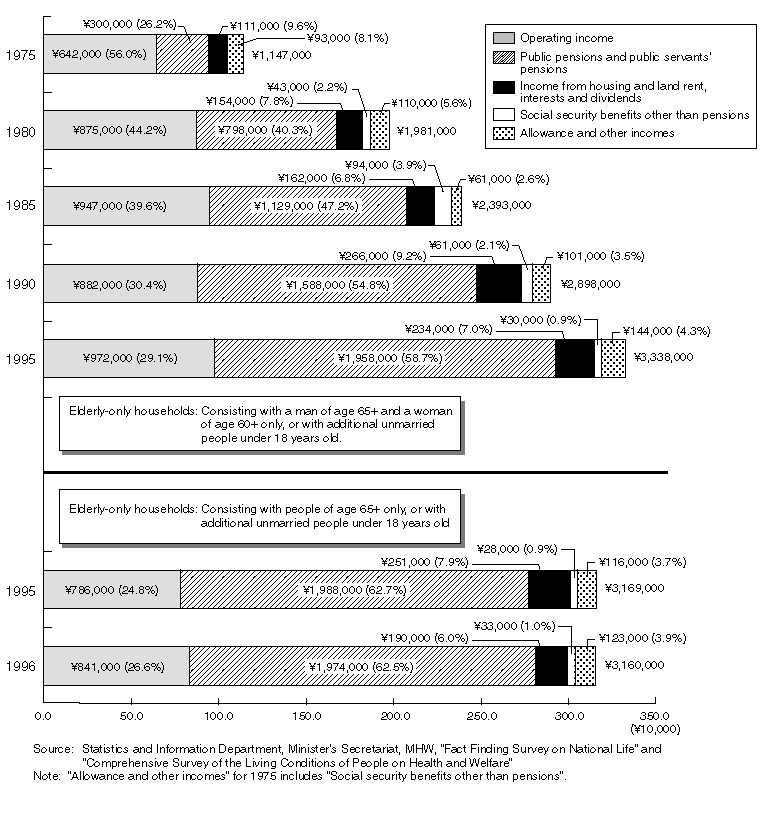
Figure 3-2-6. Component Ratio of Households by the Ratio of Pensions and Public Servants' Pensions to Total Income in Elderly-only Households Receiving Pensions and Public Servants' Pensions
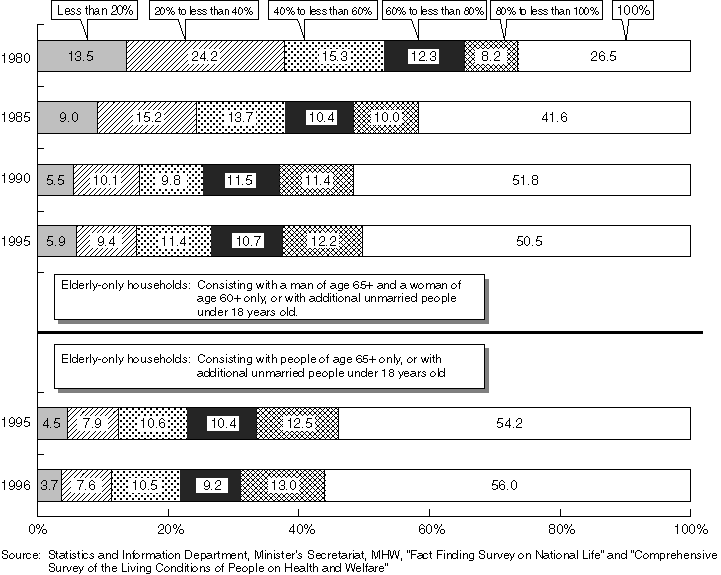
Figure 3-2-7. Incomes and Expenditures of Elderly Couple's Households without Employment
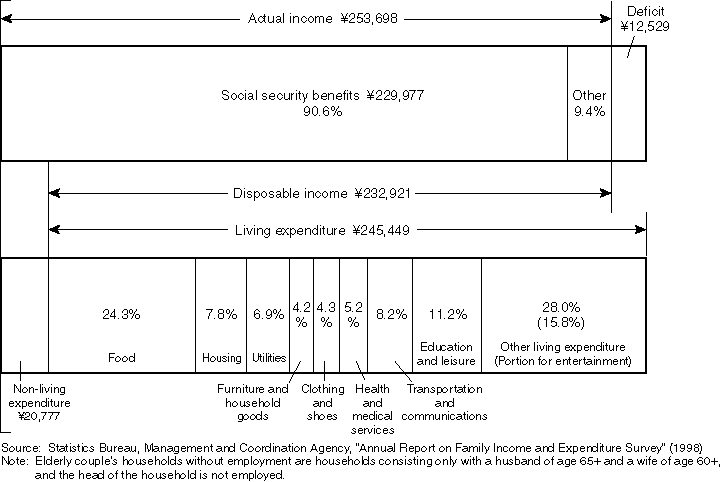
(4) Preparing social capital using the pension reserve fund
Premiums for the Employees' Pension and the National Pension are utilized to pay the pension benefits, and the Trust Fund Bureau of the Ministry of Finance will save the remaining as reserve fund. At the end of March 1998, the pension reserve fund reached \134 trillion.
Along with the postal savings fund, the pension reserve fund is utilized as the source fund for the National Government's fiscal investments and loan programs, and provided as loans to government related financial institutions as well as to local governmental organizations. Particularly, the pension reserve fund has been heavily allocated for the preparation of social capitals that are closely relating to people's living such as for housing and welfare measure, medical institutions, waste disposal facilities, etc., and it has made great contributions to the improvement of living environment.
1-4. The Standard of Old-age Pension Benefits in International Comparison
As we compare the standards of pension benefits with foreign countries, we must be aware of various differences among different countries including the mechanisms of the pension systems, employment structure, family structure, duration of subscription, etc. When the premium payment and subscription period determine the amount of benefit, the burden of premium payment should be taken in consideration. Also, we need to be aware of possible difference in funding methods and components of fund source.
While keeping these variables in mind, we attempt to compare the levels of average Employees' pension benefits in Japan with those in the U.S., the U.K., Germany and Sweden. According to the data from fiscal 1993, the monthly benefit in Japan was \159,000, which is the highest among Germany (\75,000), Sweden (\58,000 as a basic pension for a married couple, and \63,000 of added pension), the U.K. (\64,000 as a basic pension for a married couple, and \15,000 of added pension), and the U.S. (\69,000 for a single, and \103,000 for a married couple). However, the wage level is also high in Japan and the ratio of the average pension benefit to the average wage (manufacturing industry) of current working generation is 43%. This ratio in other countries is 31% in Germany, 58% in Sweden, 43% in the U.K. and 32% for singles and 48% for married couples in the U.S. According to this data, the level of the Employees' Pension benefit is comparable to other nations.
1-5. Discussions on the Employee's Pension
(Fairness of benefit and burden among different generations)
As explained in 1-2(4), the Employees' Pension is operated based on the stepwise raising premium method, and it has been pointed out that this type of financing method would create inequality between generations because the gaps between the total premium payments and the total pension benefits will grow with the progress of aging society with fewer children. However, the public pensions system is one of social security systems that provides a mutual assistance system to the entire society and to offer benefits to those who need.It is not a type of system to be evaluated solely on the basis of one's loss and gain. When we talk about fairness between generations, we must consider the balance between generations in a broad view beyond the pensions, and be aware of the fact that many of the current pension beneficiaries belong to the generation which had to look after their parents at their own expense. We also need to recognize that there are varieties of fund transfers from the elderly to the working generation.
(Abolition of the Employees' Pension (privatization) and financial security in advanced age)
The recent arguments to point out the potential for intergenerational imbalance of benefit and burden for public pensions and the recent tones in discussions to accelerate the streamlining of public functions are leading to the idea of adoption of the complete funding method to the financing method of the Employees' Pension and its privatization so that the advancement of the aging society with fewer children and the changes in demographic structure would not affect the pension system. The privatization of the Employees' Pension means to eliminate the involvement of public functions to the remuneration-based portion to be added to the Basic Pension, and it implies the "abolition" of the Employees' pension as public pensions.
When "the Abolition of the Employees' Pension (privatization)" is implemented, the basic pension and private pensions (corporate pensions or personal pensions) will be used to finance the retired living, and this means that the public pensions would only secure the portion of the Basic Pension (for fiscal 1999 the full benefit is \67,000 per month) for current 33 million subscribers of the Employees' Pension. In this case, financial security for the retired employees will become unstable. Even when the person is subscribing corporate pensions and personal pensions, there is a potential for a major financial crisis in retired living due to a drastic inflation because the funding method cannot respond well to inflation.
When individuals decide to take a certain investment risk with their own responsibility, and then fail as a result, they would no longer be capable of securing sufficient pensions to finance their retirement life. When the reduction of premiums for the Employees' Pension (burden of insured and business owners) is not transferred to wages or private pensions, the level of financial security for employees would dropped greatly.
(The issue of "double burden")
In order to abolish and privatize the Employees' Pension by adopting the funding method, we must resolve the issue of "double burden" of \380 trillion (in case with the current system) to yield at the transition. "Double burden" is the two types of burden imposed on the working generation during the transition to the funding method. They must bear the funding for their own pension as well as the premium payment for the benefit of the present beneficiaries which is to be covered by the future generations. Regarding this "double burden", the following issues are yet to reach agreements: Where to seek financial resource, and how to deal with the heavy burden on a certain generation in order to resolve the issue in a short time period.
According to the survey conducted to the learned people on "the Abolition of the Employees' Pension (privatization)", more than 70% responded to maintain the current two-tier system and the result shows that many people are not supportive of "the Abolition of the Employees' Pension (privatization)" (Figure 3-2-8).
Figure 3-2-8. Obligations for the Employees' Pension Benefits and the Structure of Fiscal Resource
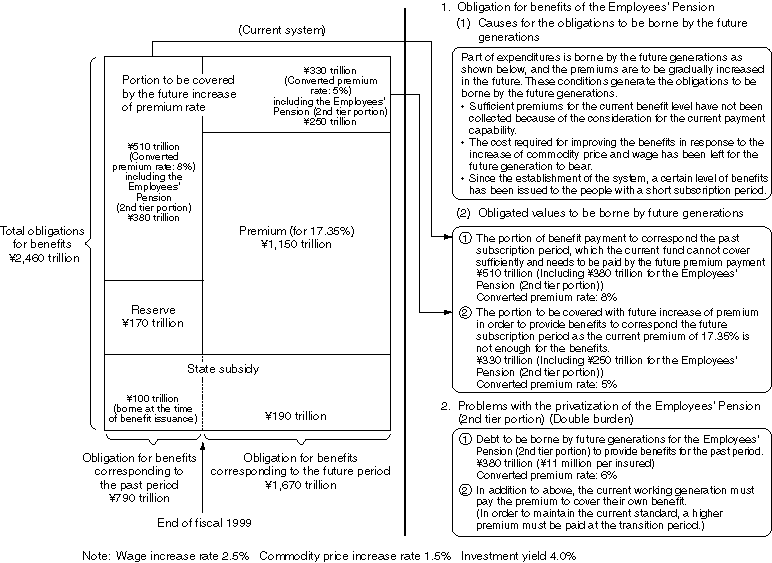
2. Security of the Minimum Standard of Living
2-1. The Public Assistance System, "The Last Resort" to Support People's Living
The public assistance system is the actual implementation of the concept to secure the right to maintain the minimum level of wholesome and cultured living stipulated in Article 25 of the Constitution, and it is based on the Public Assistance Law. In other words, it provides necessary protection to all citizens in accordance with the level of their poverty, and guarantees the minimum level of wholesome and cultured living, and it also promotes their self-sufficiency.
While public pensions are essential to the financial security system, the public assistance system plays an important role as "the last resort" for the indigents.
2-2. Improving the Standards of Various Benefits and Livelihood Aid
(1) Public assistance benefits to meet various needs
The benefits provided by the public assistance system include the following seven types; livelihood aid, education aid, housing aid, medical aid, delivery aid, occupational aid and funeral aid. These benefits finance basic living as well as various needs in our daily living such as housing cost, medical treatment cost, delivery cost, etc. Starting in April 2000, a long-term care aid will be added in response to the long-term care insurance, and this addition will make the total 8 types of benefits.
In fiscal 1996, the expenditure for public assistance was \1,545.3 billion, and about 90% of the expenditure were spent on medical aid (approx. 57%) and livelihood aid (approx. 32%). Major reasons for the high ratios in these area are that an overwhelmingly high number of households have begun to receive the benefit due sickness and injury, and that the beneficiaries of the public assistance aids are exempted from the National Health Insurance although the scheme of Japan's medical insurance is a universal medical insurance system.
(2) Improving the standard of livelihood aid benefits
The initial standard of benefit provided by the livelihood aid of the public assistance system was viewed as low level compared to the standard of living of general public, but along with the economic development the calculation method for the public assistance benefits was revised and the standard was raised. Starting in 1965, the gap reduction method was adopted to reduce the difference between the standards of living of general public and the beneficiaries of public assistance, and starting in fiscal 1984 the standard equalizing method was adopted to revise the benefit with consideration of people's consumption patterns, and the benefit has been revised every year since then. As a result of these revisions, the level of living expenditure of the households receiving the public assistance is now about 70% of the level of general working households.
As an example, the livelihood aid for a standard family with three people in a urban area is \163,806 monthly in fiscal 1999.
2-3. Changes in the Beneficiaries of Public Assistance and Their Characteristics
As indicated in Figure 3-2-9, the number of beneficiaries of public assistance has decreased to around 900,000 people in recent years, but it is beginning to increase after fiscal 1996.
According to the historical data, more than two million people were receiving public assistance around 1950 when the current system had just begun, but by 1965 the number dropped to less than 1.6 million people. The strong economy conditions known as Jinmu boom and Iwato boom were contributing factors to the improvement, and also in early 1970s various laws including the Law for the Welfare of People with Mental Retardation (currently called the Law for the Welfare of Mentally Disadvantaged Persons), the Child Rearing Allowance Law, and the Welfare Law for the Elderly were enacted to create a social welfare system to prevent poverty and to provide assistance to the households requiring relief such as elderly people, mentally disadvantaged people, and fatherless families.
Later, during the period called the high economic growth the overall standard of living improved, and in 1970 the number of public assistance beneficiaries decreased to the level of 1.3 million people. However, in 1973 the oil crisis hit the economy and the number began to rise again and reached to nearly 1.47 million people in 1984.
Later in 1980s, the number of beneficiaries began to drop again. In the background to the improvement, the economy was strong continuously and another contributing factor was the establishment of the Disability Basic Pension with the revision of the pension system in 1986. As shown in Figure 3-2-10, the number of households with disabled people and receiving public assistance decreased by approximately 35,000 from 1986 to 1987, which is a large decrease of almost 40%. Thus, the number of beneficiaries of public assistance changed with the influence of economic conditions as well as the changes in social security systems and pensions.
According to the descriptions of households receiving public assistance in Table 3-2-11, the number of elderly-only households is increasing to reach 45% of the total in 1997. Among the elderly-only households, the ratio of single households is particularly high and within that segment the number of households with single living woman is increasing.
While ratio of families living with elderly parents is dropping and the idea of supporting elderly parents is changing, it is likely that the ratio of single living elderly-only households increases with the expansion of elderly population in the future. Considering the circumstance, it is important to secure a stable financial security system for the life after retirement, centering on the public pensions which could influence the condition of supplying public assistance.
Figure 3-2-9. Changes in the Number of People Receiving Public Assistance
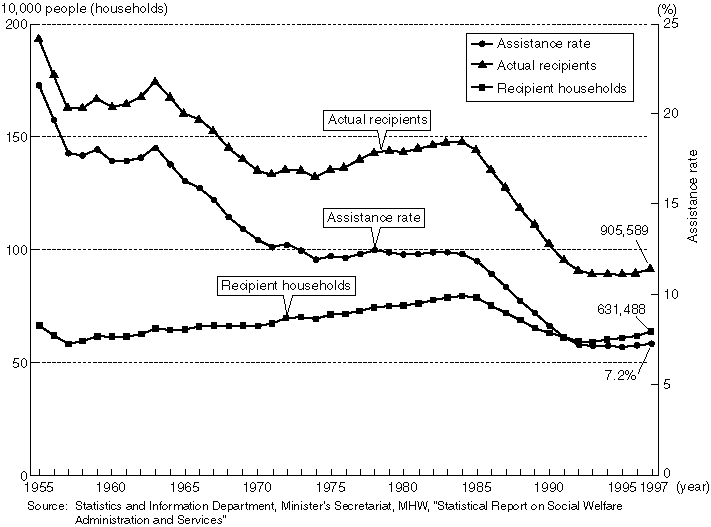
Figure 3-2-10. Changes in the Number of Households Receiving Public Assistance by Household Type
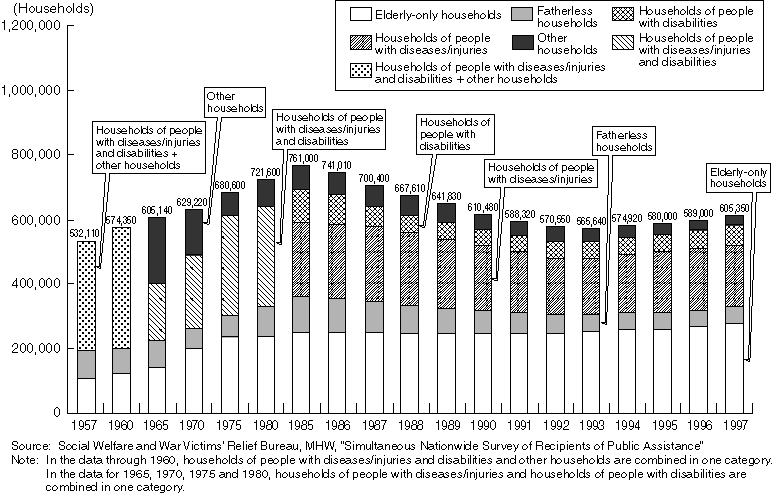
Table 3-2-11. Number of People Receiving Public Assistance by Gender and Age Group

2-4. International Comparison of Public Assistance System
While the U.S. and European countries have similar public assistance systems to Japan's, there are differences in mechanisms, eligible people, types of assistance and status of actual utilization, as indicated in Table 3-2-12.
For example, the U.S. has a system to provide cash benefits to the elderly and the disabled people with low income, but does not have a comprehensive assistance system like public assistance in Japan. Public assistance available to all U.S. citizens is limited to Medicaid (medical aid) with benefit in kind and food stamps (coupons for food purchase only). Other five nations than the U.S. have public assistance systems designed for all citizens, but in case of the U.K., the system is divided into a few categories based on the criteria such as employment capability, having children, etc. France applies different systems depending upon whether the person is elderly or unemployed. In contrary, Germany and Sweden have one system for all citizens like Japan.
Table 3-2-12. Comparison of Public Assistance Systems in the U.S. and Major European Countries
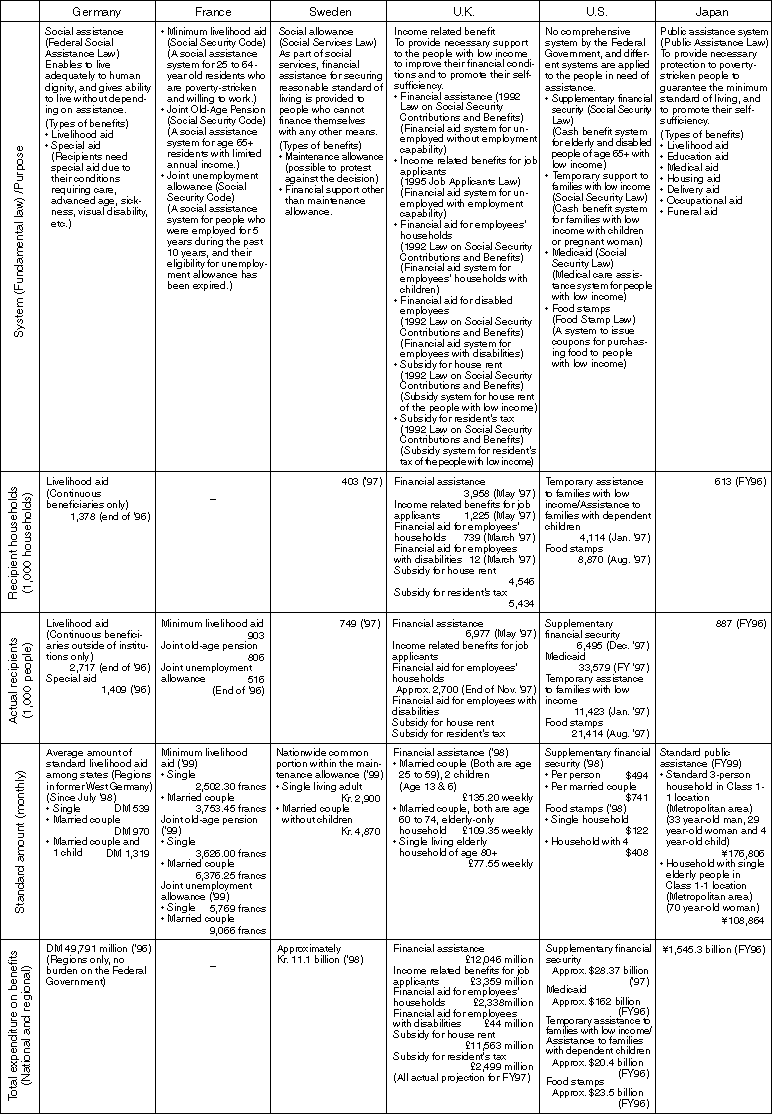
Types of available assistance are also different by country. As an example, France provides benefit to unemployed people. The U.K. has two financial security systems to unemployed people. This is part of measures taken by Blair administration in 1996 to increase the incentives for taking jobs, and the unemployed people who are capable of working are classified as beneficiaries for income related benefit for job applicants who are required to seek jobs, and they are excluded from the subject for regular financial aid. In case of Germany, the standard value of livelihood aid is different in each state, as it is a federal state country.
As we reviewed, the mechanisms and contents of assistance are different in each country and making a general statement is not very adequate, but the number of beneficiaries is relatively high in the U.S. and European nations compared to Japan. Possible reasons for a relatively small number of people receiving public assistance in Japan would be the security of living provided by other social security systems such as social welfare systems and pension systems, and also the practice of a wide range of private support as stipulated in the Civil Law which is actually in practice. In case of the U.S., Medicaid is applied to about 36.3 million people (about 13% of total population), and 21.4 million people (about 8% of total population) are receiving food stamps. In the U.K. about seven million people are receiving financial aid, and in Sweden about 0.75 million people (about 8% of total population) are receiving social benefits.